

Visual RDF. RDF Translator. RDF 1.1 Concepts and Abstract Syntax. Abstract The Resource Description Framework (RDF) is a framework for representing information in the Web.

This document defines an abstract syntax (a data model) which serves to link all RDF-based languages and specifications. RDF 1.1 Primer. Abstract This primer is designed to provide the reader with the basic knowledge required to effectively use RDF.
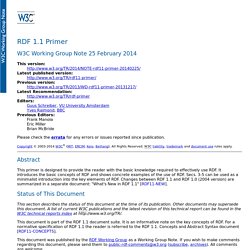
It introduces the basic concepts of RDF and shows concrete examples of the use of RDF. Secs. 3-5 can be used as a minimalist introduction into the key elements of RDF. Changes between RDF 1.1 and RDF 1.0 (2004 version) are summarized in a separate document: "What's New in RDF 1.1" [RDF11-NEW]. Status of This Document. Semantic Web. I have an idea that I think is very important but I haven’t yet polished to the point where I’m comfortable sharing it.

I’m going to share it anyway, unpolished, because I think it’s that useful. So here I am, handing you a dull, gray stone, and I’m saying there’s a diamond inside. Maybe even a dilithium crystal. My hope is that a few experts will see what I see and help me safely extract it. Cern.info.ch - Tim Berners-Lee's proposal. Tools - Semantic Web Standards. Overview This Wiki contains a collection of tool references that can help in developing Semantic Web applications.

These include complete development environments, editors, libraries or modules for various programming languages, specialized browsers, etc. The goal is to list such tools and not Semantic Web applications in general (the interested reader may consider looking at the W3C SW Use Case Collection for those.) The tool content of this wiki is still to be maintained by the community and not by the W3C staff. If you are interested in adding to and/or modifying the relevant pages, please consult the separate Tool Contributors’ page.
W3C Data Activity - Building the Web of Data. More and more Web applications provide a means of accessing data.

From simple visualizations to sophisticated interactive tools, there is a growing reliance on the availability of data which can be “big” or “small”, of diverse origin, and in different formats; it is usually published without prior coordination with other publishers — let alone with precise modeling or common vocabularies. The Data Activity recognizes and works to overcome this diversity to facilitate potentially Web-scale data integration and processing.
It does this by providing standard data exchange formats, models, tools, and guidance. The overall vision of the Data Activity is that people and organizations should be able to share data as far as possible using their existing tools and working practices but in a way that enables others to derive and add value, and to utilize it in ways that suit them. Linked Data - Design Issues. Up to Design Issues The Semantic Web isn't just about putting data on the web.
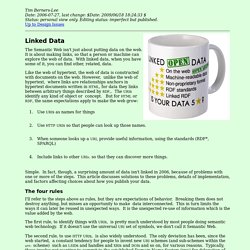
It is about making links, so that a person or machine can explore the web of data. With linked data, when you have some of it, you can find other, related, data. Like the web of hypertext, the web of data is constructed with documents on the web. Linked Data: Evolving the Web into a Global Data Space. The Linking Open Data cloud diagram. The W3C Markup Validation Service.
Berners-Lee: Weaving the Web. Supplementary material to the book The original design and ultimate destiny of the World Wide Web, by its inventor Buy: from Amazon.com (paperback), Barnes & Noble (paperback), Booksamillion (paperback), Borders (paperback), Powells (paperback), or Wordsworth(paperback). * This book is written to address the questions most people ask - From "What were you thinking when you invented it?
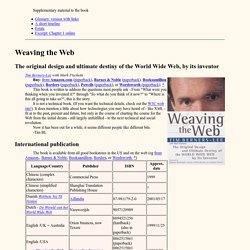
" How It All Started. A Little History of the World Wide Web. See also How It All Started presentation materials from the W3C 10th Anniversary Celebration and other references. from 1945 to 1995 Vannevar Bush writes an article in Atlantic Monthly about a photo-electrical-mechanical device called a Memex, for memory extension, which could make and follow links between documents on microfiche 1960s Doug Engelbart prototypes an "oNLine System" (NLS) which does hypertext browsing editing, email, and so on.
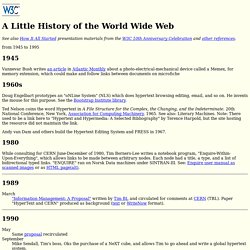
Standards. W3C standards define an Open Web Platform for application development that has the unprecedented potential to enable developers to build rich interactive experiences, powered by vast data stores, that are available on any device.
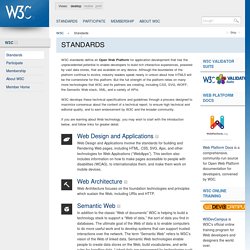
Although the boundaries of the platform continue to evolve, industry leaders speak nearly in unison about how HTML5 will be the cornerstone for this platform. But the full strength of the platform relies on many more technologies that W3C and its partners are creating, including CSS, SVG, WOFF, the Semantic Web stack, XML, and a variety of APIs. W3C develops these technical specifications and guidelines through a process designed to maximize consensus about the content of a technical report, to ensure high technical and editorial quality, and to earn endorsement by W3C and the broader community.
If you are learning about Web technology, you may wish to start with the introduction below, and follow links for greater detail. World Wide Web Consortium Process Document. The mission of the World Wide Web Consortium (W3C) is to lead the World Wide Web to its full potential by developing common protocols that promote its evolution and ensure its interoperability.
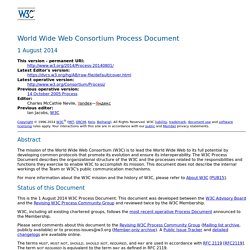
The W3C Process Document describes the organizational structure of the W3C and the processes related to the responsibilities and functions they exercise to enable W3C to accomplish its mission. This document does not describe the internal workings of the Team or W3C's public communication mechanisms. W3C HTML. In October 2014, the HTML Working Group published HTML5 as W3C Recommendation. This specification defines the fifth major revision of the Hypertext Markup Language (HTML), the format used to build Web pages and applications, and the cornerstone of the Open Web Platform. “Today we think nothing of watching video and audio natively in the browser, and nothing of running a browser on a phone,” said Tim Berners-Lee, W3C Director.
“We expect to be able to share photos, shop, read the news, and look up information anywhere, on any device. Though they remain invisible to most users, HTML5 and the Open Web Platform are driving these growing user expectations.” URL. Cern.info.ch - Tim Berners-Lee's proposal. FileStructure65.pdf. As We May Think.
As Director of the Office of Scientific Research and Development, Dr. Vannevar Bush has coordinated the activities of some six thousand leading American scientists in the application of science to warfare. In this significant article he holds up an incentive for scientists when the fighting has ceased. He urges that men of science should then turn to the massive task of making more accessible our bewildering store of knowledge.